



Daguerrotype of Daniel Webster from Mathew Brady's studio, ca. 1845-1849, from the Library of Congress.
Benjamin Perley Poore's Perley's Reminiscences of Sixty Years in the National Metropolis (Hubbard Brothers, Publishers, Philadelphia, 1886, p. 87) includes a description of 1820's Christmas festivities: “… there was scarcely a house in Washington in which there was not a well-filled punch bowl. In some antique silver bowls was ‘Daniel Webster punch,’ made of Medford rum, brandy, champagne, arrack, maraschino, strong green tea, lemon juice, and sugar; in other less expensive bowls was found a cheaper concoction. But punch abounded everywhere, and the bibulous found Washington a rosy place….”
It can be speculated that the “bibulous” may have tended to believe themselves as oratorically skilled and eloquent as the famed Daniel Webster after imbibing the punch which bore his name!
In response to a request posted on this website, researcher and bibliophile Brian Rea provides from his collection the following recipe, quoted from Haney's Steward & Barkeeper's Manual, published by Jesse Haney & Co., 110 Nassau Street, New York City, 1869:
273. – Daniel Webster's Recipe For Punch
If the god-like Daniel cared nothing for riches he did love a good punch, and he knew how to concoct a drink fit for gods. Some time before his death, he gave his old life long friend, Major Brooks, of Boston, his benefaction and blessing, and left him, as the last earthly good he could bestow, the following recipe for what is now known here among the elect, as the Webster punch. It is composed of “one bottle of pure old French brandy (smuggled direct preferred), one bottle sherry, one ditto old Jamaica rum, two ditto claret, one ditto champagne, one dozen lemons, one pint strong tea, sugar, strawberries, and pineapple to suit the taste, plenty of ice, no water.” It is to be observed that no water enters into this composition.
Copyright © 1999–2009 Patricia B. Mitchell.